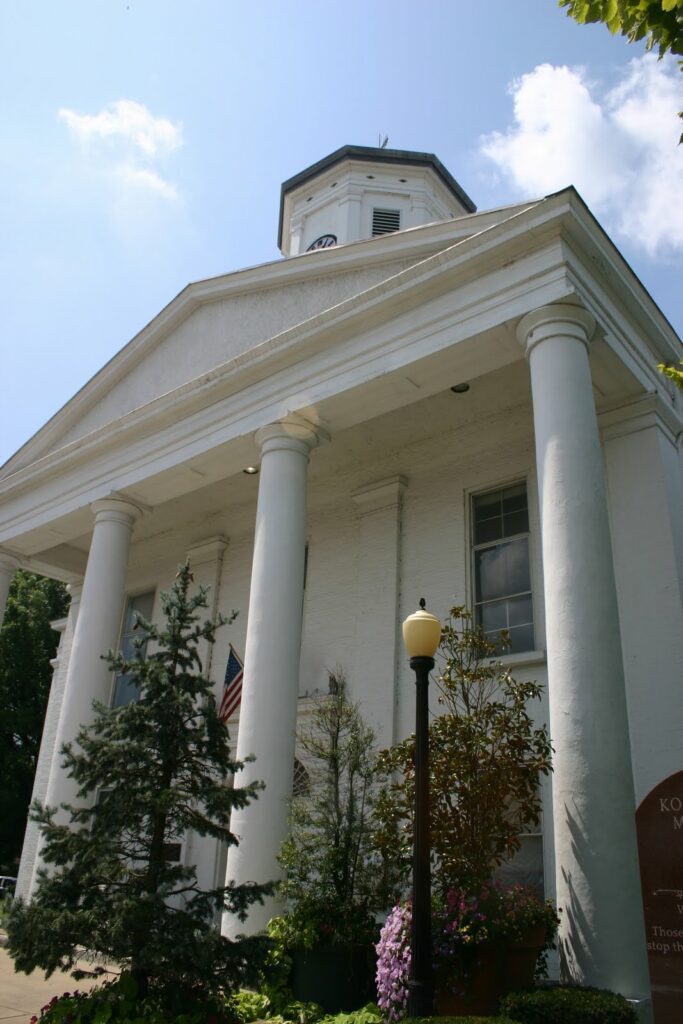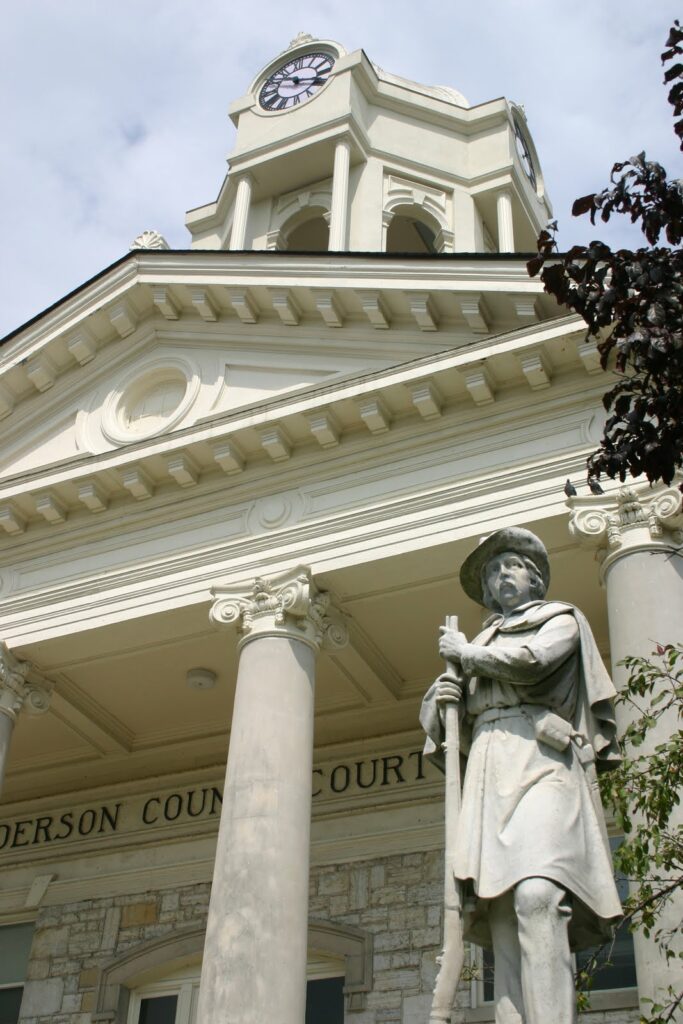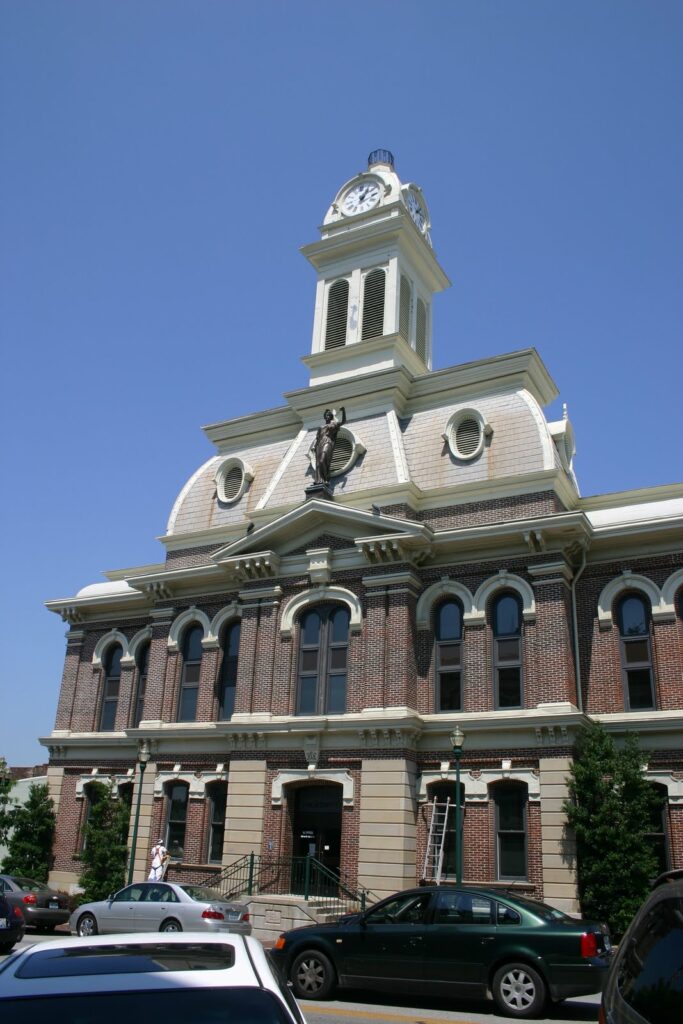
I was feeling a little sleepy today, so my trip to Georgetown was my only stop. This was not the first time I’ve seen the Scott County Courthouse, and its still pretty amazing. I like how much the courthouse is clearly built to be viewed from the front. With the statute of justice and the way in which the tower is pushed towards the front makes it pretty unique, I think. According to Wikipedia, this is the fourth courthouse on this spot, the land for which was first donated by Elijah Craig. The style is apparently “Second Empire” – named after the Second French Empire, most notable for the mansard roof style that is so apparent here on the courthouse up by lady justice. The total cost of this beautiful building back in 1877? – $34,600,
Bourbon County Courthouse – Paris, Ky.
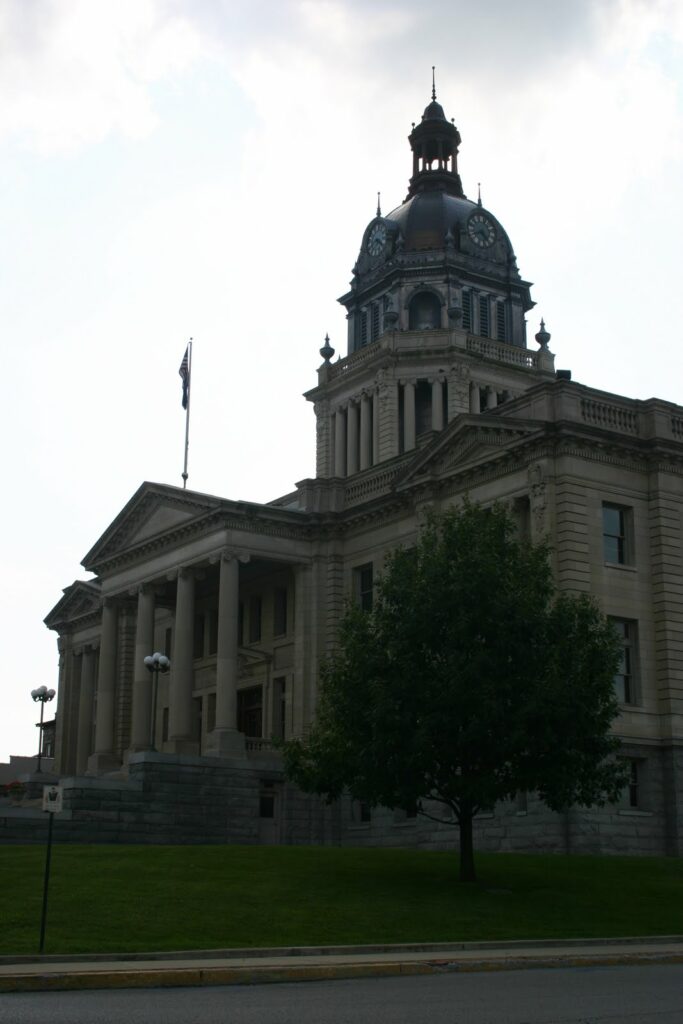
Bourbon County’s courthouse in Paris gets a lot of attention, and rightfully so. It’s pretty impressive. It sits up at the top of the hill in Paris, and dominates the downtown area. I’m not sure if its always been this way, but it looks like some of the old buildings on the courthouse square have been torn down over the years, leaving a bunch of open parking areas downtown.
In another French connection with the Commonwealth, according to the historic marker Bourbon County was named for the French Royal family for the assistance given during the Revolutionary War. Bourbon was among the original counties of Virginia. the first courthouse was constructed on this site in 1787. At that time, Paris was called “Hopewell.”
I was told by my friend Kyle that the reason the Bourbon County Courthouse is so huge and ornate is that at the time of its construction, Frankfort had not been chosen as the state capital and Paris was still in the running.
No Destination 8-8-09
It might be a stretch to call this post a “no destination.” I was in Bardstown, Kentucky for a wedding this past Saturday and I had about an hour-and-a-half to kill. I headed into downtown, parked the car and began to explore.
Bardstown is best known as the site of Federal Hill, a/k/a My Old Kentucky Home. Relaxing on the grounds of this property, composer Stephen Foster wrote the words and music of the song that would become Kentucky’s state anthem.
Downtown is marked by a large rotary with the old courthouse in the middle. Bardstown, a ville strongly focused on historical preservation, now uses its old courthouse as a visitors center. (The new courthouse is not downtown; it’s next to the Bluegrass Parkway.)
The focus on historical preservation is everywhere – older homes and business are marked with plaques indicating the history of the structures. All in all, Bardstown is a great little ville. I hope to return to see the proto-cathedral of St. Joseph; apparently Bardstown was an important center of American Catholic life.
Without adieu…the pictures (be sure to read the captions):
Oh, and one more interesting fact. The first successful leg amputation (at the hip joint) was performed on a 17-year-old patient in Bardstown in 1806.
Montgomery County Courthouse – Mt. Sterling, Ky.
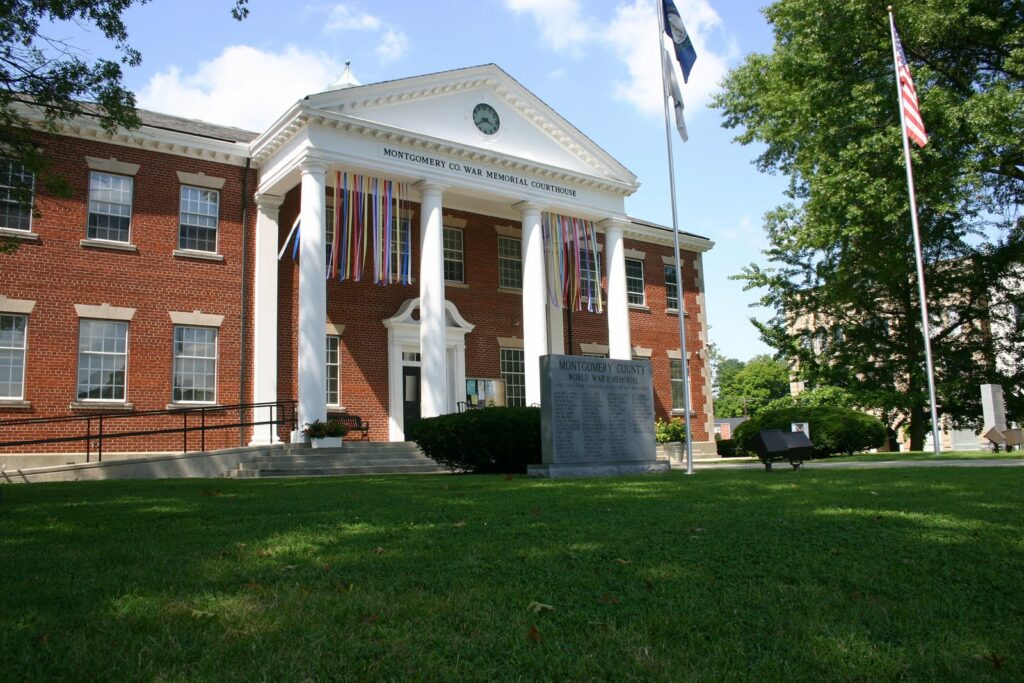
Mt. Sterling is a beautiful town, but I have to admit I was a little disappointed by the courthouse. It’s pretty much a new building, and if I didn’t know any better it could have been a bank. The area surrounding the courthouse, though, is particularly cool. It’s surrounded by brick streets and painstakingly restored buildings. Yet again, another cool town I can imagine being very cool to live in.
Like the Bath County Courthouse, the Montgomery County Courthouse was burned in the Civil War. According to the historical markers, Confederate Cavalry burned the courthouse on Dec. 2, 1863 in order to prevent its use as a Union garrison.
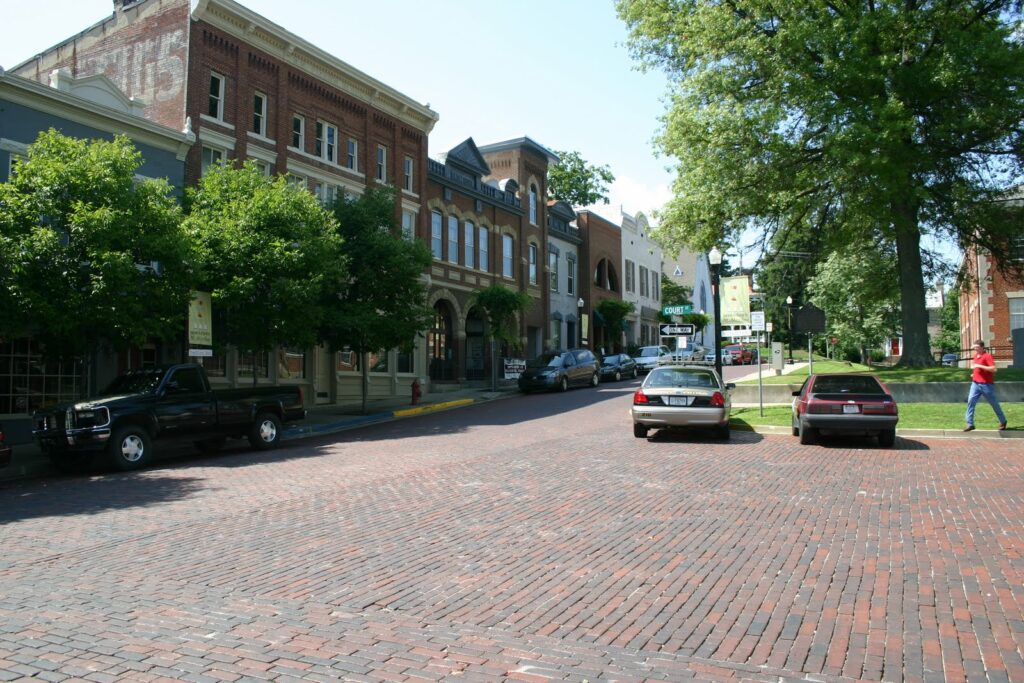
* EXTRA PIC FOR PETER – above is the aforementioned really awesome brick streets and restored buildings that surround the courthouse.
Bath County Courthouse – Owingsville, Ky.
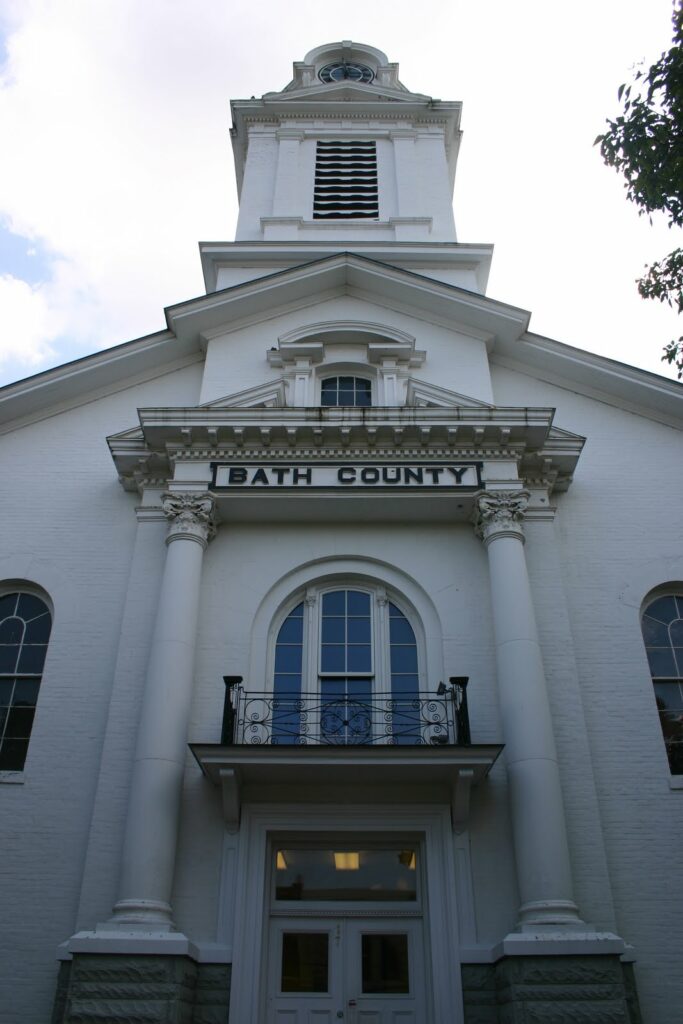
Okay, so I had never, ever even heard of Owingsville. But there is a ton of history here. And how did Bath County get its name? Surprisingly, it was given the name because people used to come here to take baths. Seriously. According to the sign at the courthouse square, there were many well known mineral springs in the area. Bath County was also home for some time to Louis Philippe, the last King of France during his exile. Weird, huh?
Anyway, according to the signs at the courthouse, the Bath County Courthouse was among the 22 courthouses burned during the Civil War. But the burning of Bath’s courthouse was unintentional. As Confederate forces approached, the Union soldiers abandoned the area and an overheated stove started the fire.
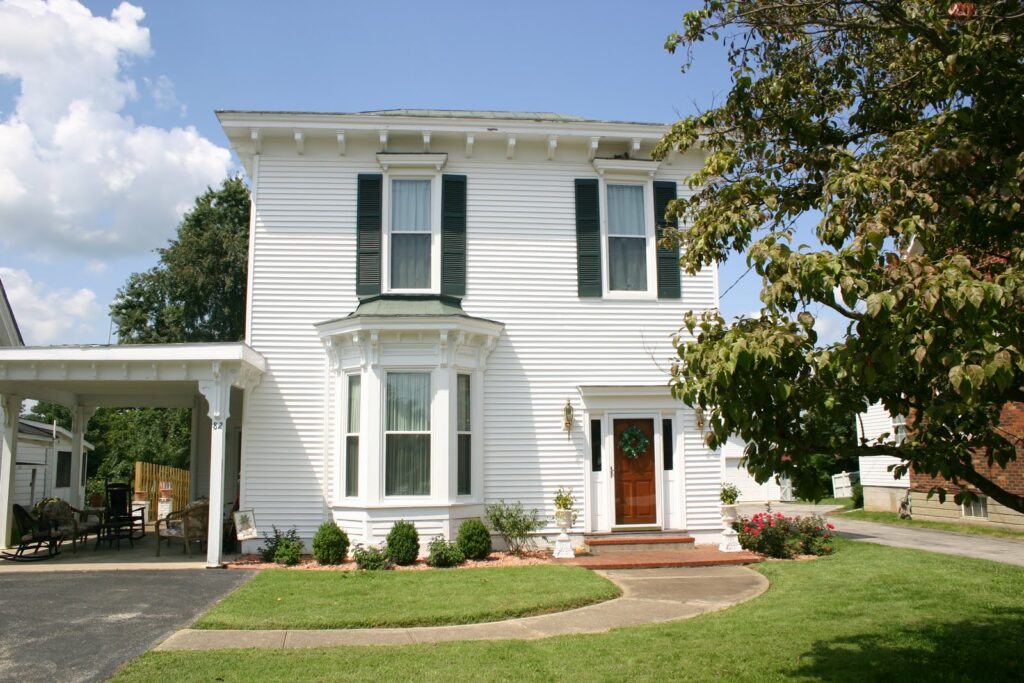
* BONUS PIC FOR PETER – So this one caught me completely off guard. You know General John Bell Hood? Famous Confederate General remembered for Gettysburg, Chickamauga, Fredricksburg, etc.? He was born in this house in Owingsville. I had no clue.
Nicholas County Courthouse – Carlisle, Ky .
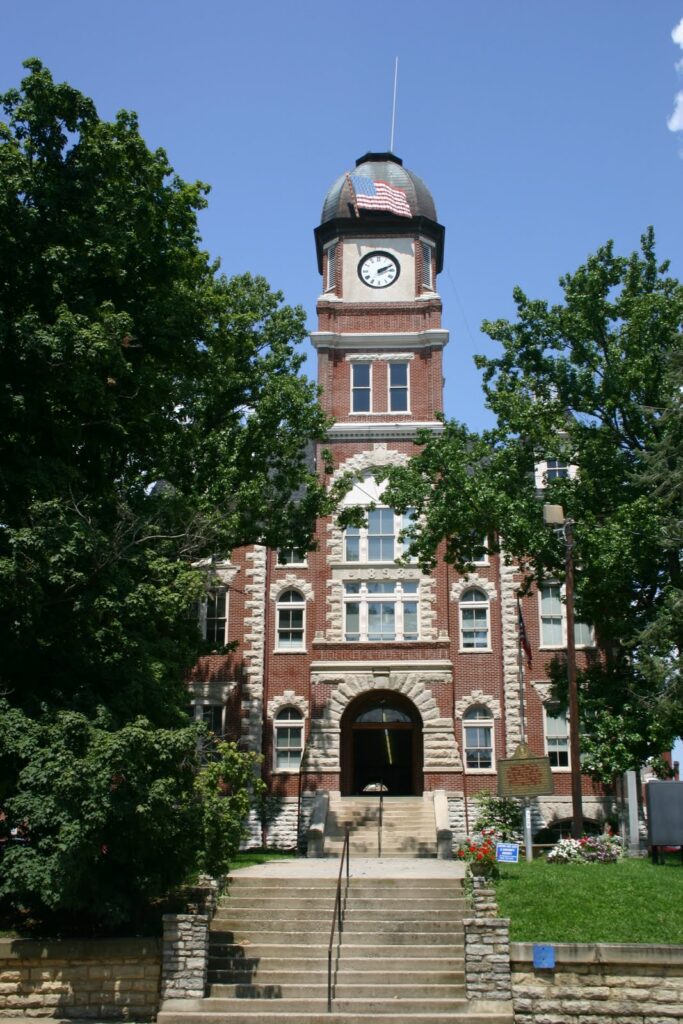
Nicholas County is a special place for me, because it is the childhood home of my best friend Kyle. Ever since I’ve known him, I’ve been regaled with tales of Nicholas County. This wasn’t my first time in Carlisle, but it was the first time I visited the courthouse. It’s a beautiful building that sits up high on the square, and is pretty impressive. The light-up flag on the top of the cupola is sorta depressing on a historic building, but I bet it looks pretty sweet at night. One thing I noticed about Carlisle was that it seemed to have a pretty large downtown for the less than 2,000 people who live there. Kyle informed me today that prior to the Great Depression, Carlisle was comparable to Lexington as a hub for tobacco and livestock commerce. Now, it has what might be the most disturbing and terrifying museum I have ever seen – A doll and toy museum. I swear, the museum’s windows house these two larger dolls that sit and stare out at you with their soulless empty gaze. Man…that’s an image you can never forget.
Anyway, I’ve learned a lot about Carlisle and Nicholas County today, as Kyle informed me that:
* it used to be the cite of Blue Lick Springs, a 300-room hotel and spa.
* it is the birthplace of both Gatewood Galbraith and Barbara Kingsolver.
* Daniel Boone also lived in Nicholas County for a while.
Harrison County Courthouse – Cynthiana, Ky.
I set out this morning knowing that I would drive to Cynthiana to begin my trip through the east/central part of the Bluegrass, but I really had no idea what I was in for. I must admit that I got a bit lost on the way to Cynthiana, but getting a little lost was probably the best thing I could have done. This area of Kentucky is absolutely gorgeous. If you want to see some of the most beautiful stone fences and rolling countryside, follow my route. It was amazing. What continues to suprise me on these trips is how completely distinct different areas of Kentucky are. Owen County and Harrison County nearly touch each other, but they couldn’t be more different in geography.
Anyway, Cynthiana is a pretty little town, with a motto that is something like “A town as beautiful as its name.” I learned at the courthouse that the origin of the name “Cynthiana” is actually a pretty interesting story. According to the plaque on the courthouse, Robert Harrison (interestingly, not the county’s namesake, but the man who donated land for the courthouse square) had two daughters – Cynthia and Anna. Combining the two names gave us the name of the county seat.
According to the sign on the courthouse, the present courthouse is the third – built in 1853 with the clock and bell added in 1856. Wings were added in 1914, and it was listed on the National Historic Register in 1974.
What keeps surprising me about this project is how many times I find myself thinking “I could live here.” Cynthiana was no exception.
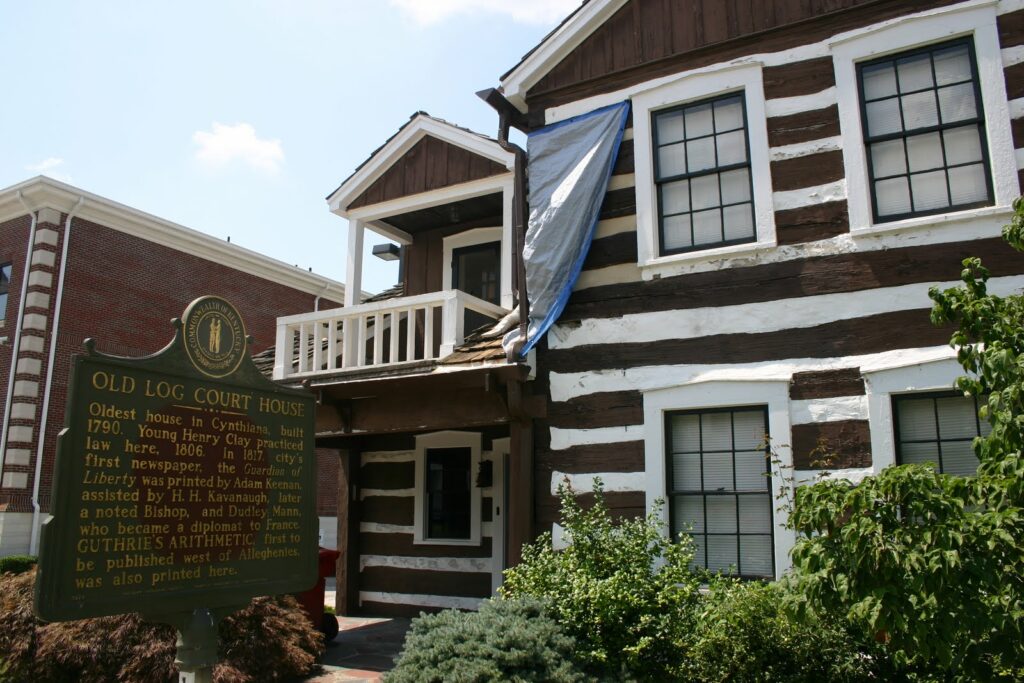
* BONUS PIC FOR PETER – I’ve decided that if I see something that is particularly noteworthy, I’m going to give everyone a bonus picture. This is labeled as the “Old Log Court House”- and has a pretty awesome history. It’s the oldest building in Cynthiana, built in 1790. Henry Clay practiced law here, and both the county’s first newspaper and a notable early arithmetic textbook were printed here.
Woodford County Courthouse – Versailles, Ky.
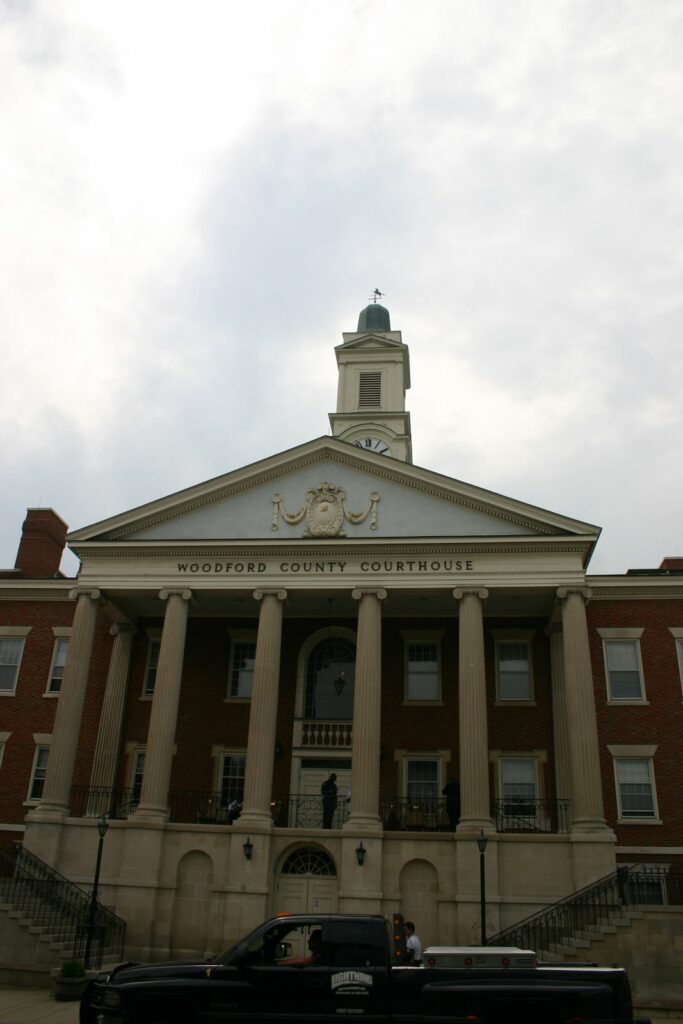 I love Woodford County. I hope someday to live there, but surprisingly, I’d never been to downtown Versailles (pronounced Ver-SALES). This was my last stop for the day, and as you can see in the picture the skies were starting to cloud up. I have to say the courthouse is pretty interesting. First off, its HUGE. It takes up the whole block, and there wasn’t an inch of green space that I could see. A courthouse with no courthouse lawn, but, to each his own I guess. At least it eliminates any of the public forum/free speech concerns that surround courthouse lawns. Anyway, there are two sets of stairs that lead up to the doors from the sides, giving the courthouse a very imposing feel – very HALLS OF JUSTICE. I like it.
I love Woodford County. I hope someday to live there, but surprisingly, I’d never been to downtown Versailles (pronounced Ver-SALES). This was my last stop for the day, and as you can see in the picture the skies were starting to cloud up. I have to say the courthouse is pretty interesting. First off, its HUGE. It takes up the whole block, and there wasn’t an inch of green space that I could see. A courthouse with no courthouse lawn, but, to each his own I guess. At least it eliminates any of the public forum/free speech concerns that surround courthouse lawns. Anyway, there are two sets of stairs that lead up to the doors from the sides, giving the courthouse a very imposing feel – very HALLS OF JUSTICE. I like it.
Changes
I have narrowed the scope of this site to focus solely on travels throughout the Commonwealth of Kentucky. I have asked my good friend, Nate, to join me in developing this blog.
Nate is on a quest to visit the courthouse in each of Kentucky’s 120 counties and has agreed to share his journey here. In the menu bar on the right is a button – click there to see only his Courthouse posts.
For those that are disappointed in the changes, weep no more my lady. The new blog will be much better!
Anderson County Courthouse – Lawrenceburg, Ky.
So . . . Anderson County has an amazing courthouse. The picture above really doesn’t do it justice. I don’t know a lot about architectural styles, but this building is a pretty amazing combination of the ornate and the simple. Huge cupola that rises tall above this small town, some really amazing Corinthian columns all on top of a base of irregular limestone bricks.
I couldn’t find much about the courthouse online anywhere, but I found a TON about the statute in the foreground. It’s one of Kentucky’s many Confederate war memorials. According to Wikipedia, (sorry), it was installed in 1894, and was placed on the National Register of Historic Places in 1997. Interestingly, the statute is not of a general – instead, it’s a Confederate soldier in winter clothes.

